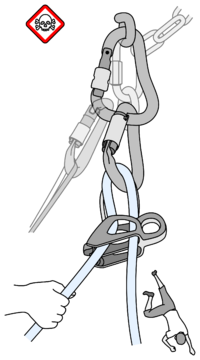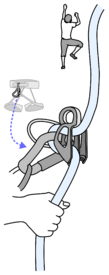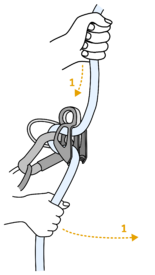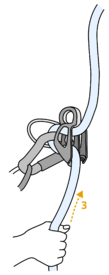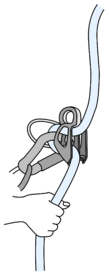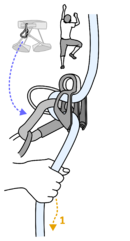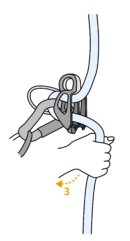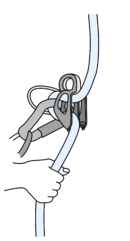Tuber (Tubular belay device): Difference between revisions
mNo edit summary |
|||
| Line 12: | Line 12: | ||
== Belaying risks == | == Belaying risks == | ||
=== General risks === | |||
Always hold/control the break strand at least with one hand and keep the break strand downwards unless giving or taking the slack. Keep your hand at least a few centimeters from the belay device to avoid pinching of the skin. Do not lift your hand too high (above the device) while giving the slack. One of the commonly seen bad habit is keeping the hand raised for a prolonged time during belaying. | Always hold/control the break strand at least with one hand and keep the break strand downwards unless giving or taking the slack. Keep your hand at least a few centimeters from the belay device to avoid pinching of the skin. Do not lift your hand too high (above the device) while giving the slack. One of the commonly seen bad habit is keeping the hand raised for a prolonged time during belaying. | ||
| Line 33: | Line 34: | ||
|196px | |196px | ||
|Do not leave the hand in the upper position if not taking or giving the slack. | |Do not leave the hand in the upper position if not taking or giving the slack. | ||
}} | |||
=== Anchor-belay risks === | |||
Unlike during belay at a ground level, during anchor belay, climber can get below the tuber level in case of a fall, which leads to additional risks. | |||
{{#invoke:FlexGallery|gallery_with_widths | |||
|File:tuber_belaying_lead_anchor.png | |||
|267px | |||
|While belaying from the anchor, redirect the rope in a way that it points upwards even in a case of a fall. | |||
|File:tuber_belaying_danger_noredirect.png | |||
|200px | |||
|If the rope is not redirected properly, tuber rotates into a non-breaking position during a fall, which easily results into a ground fall. | |||
}} | }} | ||
Revision as of 04:29, 31 August 2025
Tubular belay devices are the most commonly used belay devices during training of advanced climbing and rescue techniques, multipitching and management of twin/double ropes. In some countries/clubs, they have been replaced by assisted tubular belay devices for single-pitch training. They are prohibited in some gyms due to alleged security concerns (for details, see the security concerns section).
Belaying risks
General risks
Always hold/control the break strand at least with one hand and keep the break strand downwards unless giving or taking the slack. Keep your hand at least a few centimeters from the belay device to avoid pinching of the skin. Do not lift your hand too high (above the device) while giving the slack. One of the commonly seen bad habit is keeping the hand raised for a prolonged time during belaying.
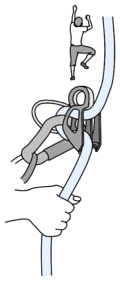
Always hold the break strand downwards unless feeding/taking the rope 
Feed or take the rope from the front of the device 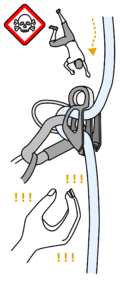
Not holding the break strand can result in fatal injuries 
Holding the break hand too close to the tuber leads to a risk of pinching the skin of the break hand index finger. 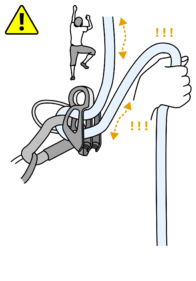
Do not lift the break hand unnecessary high during the break strand manipulation. 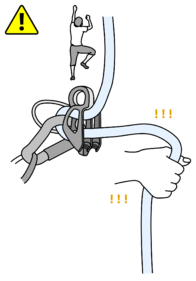
Do not leave the hand in the upper position if not taking or giving the slack.
Anchor-belay risks
Unlike during belay at a ground level, during anchor belay, climber can get below the tuber level in case of a fall, which leads to additional risks.
Belaying from the harness
Slack taking
Slack feeding
Belaying from the anchor
Belaying second climber - tuber with guide mode
Belaying lead climber - tuber with guide mode
TODO
Belaying second climber - tuber without guide mode
TODO
Belaying from harness at the anchor
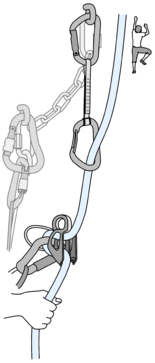
During belay from harness at the anchor point redirects the rope through the anchor till the first two pieces of the running protection are placed. Otherwise if the climber would fall, belayer would be pushed downwards and at the same time the tuber would not block as both the break strand and the live strand would be pointed the same direction.
Abseiling
TODO (redirect to technique page)
Tuber as an ascender
TODO
Security concerns
TODO


